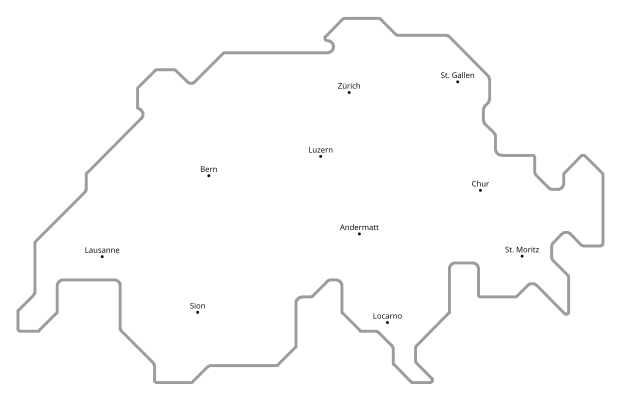Winter 2013/2014 was characterised by contrasts. On the one hand, exceptional amounts of snow fell on the southern flank of the Alps, and on the other, there were very few snow days in the Swiss Plateau. A critical avalanche situation prevailed for an extraordinarily long time in Valais and Grisons, while the snowpack remained mostly stable in the snowy south.
Residents in the Swiss Plateau could be excused for asking, "Winter? What winter?" The predominant impression from Zurich to Geneva was that the winter had ended before it had even begun, but from Christmas onwards the southern regions were groaning under the weight of the snow masses. Frequent southwesterly weather types brought so much precipitation that snowfall in the regions on the southern flank of the Alps was around twice the long-term average. In many places in Ticino, Upper Engadine and the southern valleys of Grisons, there was more snow on the ground than ever previously recorded on some days in January and February. Over the entire winter, however, none of the measuring stations posted record snow depths.
Few snow days in the Swiss Plateau
On average, winter temperatures throughout Switzerland (November 2013 until March 2014) were about 1 to 1.5 °C too high. As a consequence, the snow cover in some places in the Swiss Plateau did not exceed 5 cm (the threshold for a "snow day") on any days at all. Only winter 1989/90 had less snow on the Swiss Plateau. Although only a few snow days were registered at low altitudes on the southern flank of the Alps as well, there were considerably more such days there than on the Swiss Plateau. In Locarno, for example, there were seven snow days – more than twice as many as in Zurich, where for only three days there was more than 5 cm of snow on the ground.
Protracted critical avalanche situation in Valais and Grisons
In the period prior to Christmas, the snow cover remained shallow in most regions. In the course of December, the snowpack weakened as a consequence of faceting and the formation of large, loosely bonded crystals. As this layer was covered by subsequent snowfalls, the structure of the lower snowpack resembled a fragile house of cards. In particular between Christmas and the beginning of January, it was a primary cause of avalanches released by backcountry skiers and freeriders. In southern Valais and northern Grisons, considerable avalanche danger (level 3) persisted for an exceptionally long period, for as much as two months in some cases. On the southern flank of the Alps, the weak base was soon covered by so much snow that it no longer exerted any influence on the triggering of avalanches. Avalanches there were released primarily in the uppermost snowpack layers which were weakened by the frequent periods of heavy precipitation. Overall, however, the avalanche danger in winter 2013/14 was a little lower than the long-term average. Danger level 2 (moderate) was most frequently prevalent during the winter, although less often than usual. In contrast, danger level 1 (low) was forecast much more frequently than usual, about twice as often as indicated by the average. The perilous phase of the winter, when danger levels 3 and 4 predominated, spanned the period from the end of December until the end of February in particular.
104 avalanche accidents involving a total of 152 people were reported to the SLF by 15 April 2014. Of these, 17 people were injured and 17 lost their lives. For the period until mid-April, the number of fatalities is slightly lower than the long-term average.
Avalanche bulletins from the end of November
The SLF issued the first daily avalanche bulletin of the winter on 28 November 2013. Between 20 December 2013 and 6 April 2014, a danger evaluation was published twice daily. For the time being, the avalanche bulletin will continue to appear daily at 5 pm. It is available at www.slf.ch and via the SLF White Risk app. The SLF also offers an RSS feed and a text messaging service, which, in the early and late winter and during the summer, draws attention to the publication of an avalanche bulletin in the event of major snowfall. (To order the service, text START SLF SOMMER to 9234. To unsubscribe, text STOP SLF SOMMER to 9234. Texts cost CHF 0.20.) An Alpine weather report in German is available from MeteoSwiss (www.meteoschweiz.ch), by phone on 0900 162 138 (CHF 1.20/min.), or by fax on 0900 162 338 (CHF 2.00/min.).
